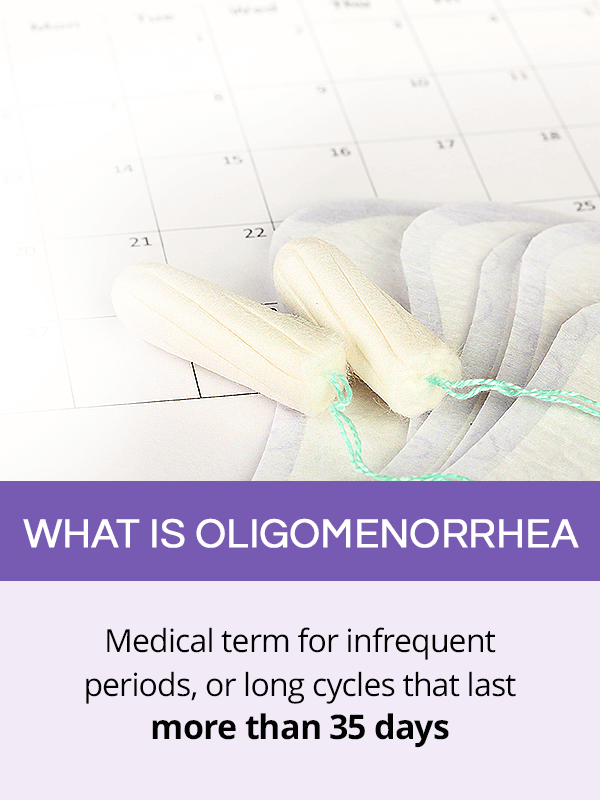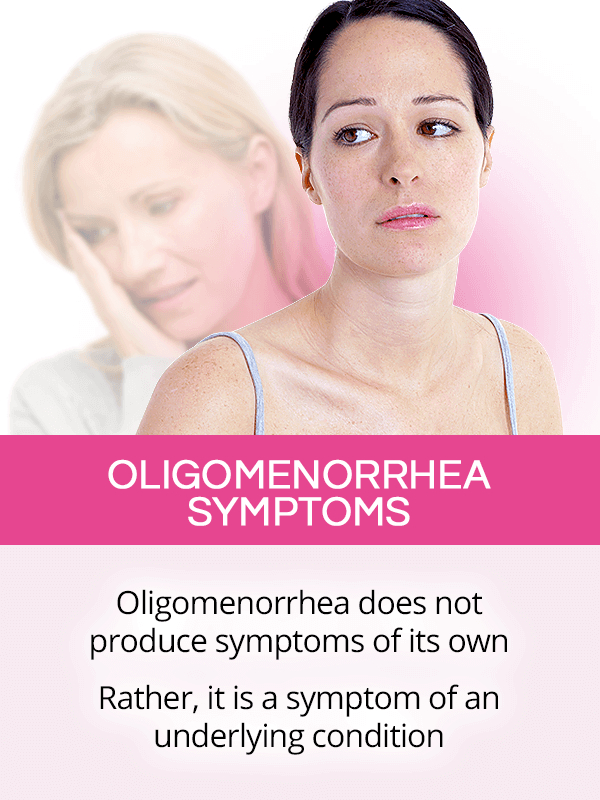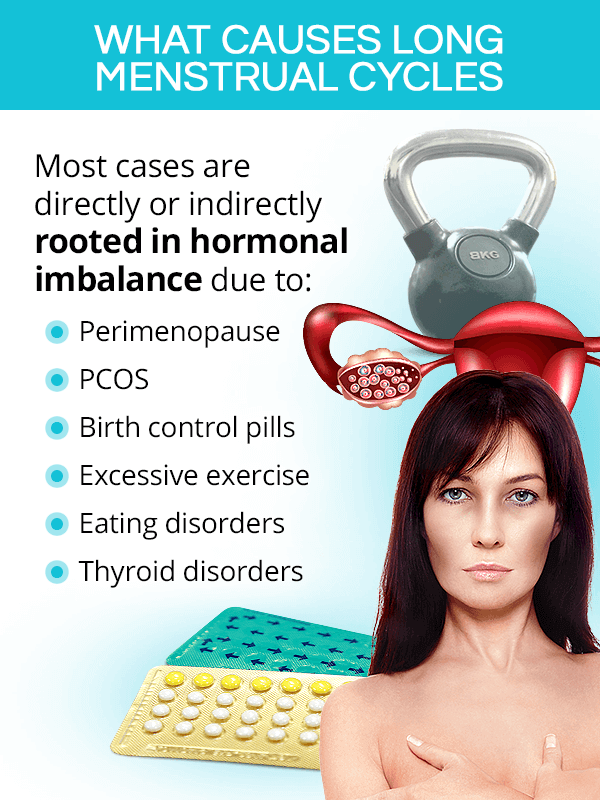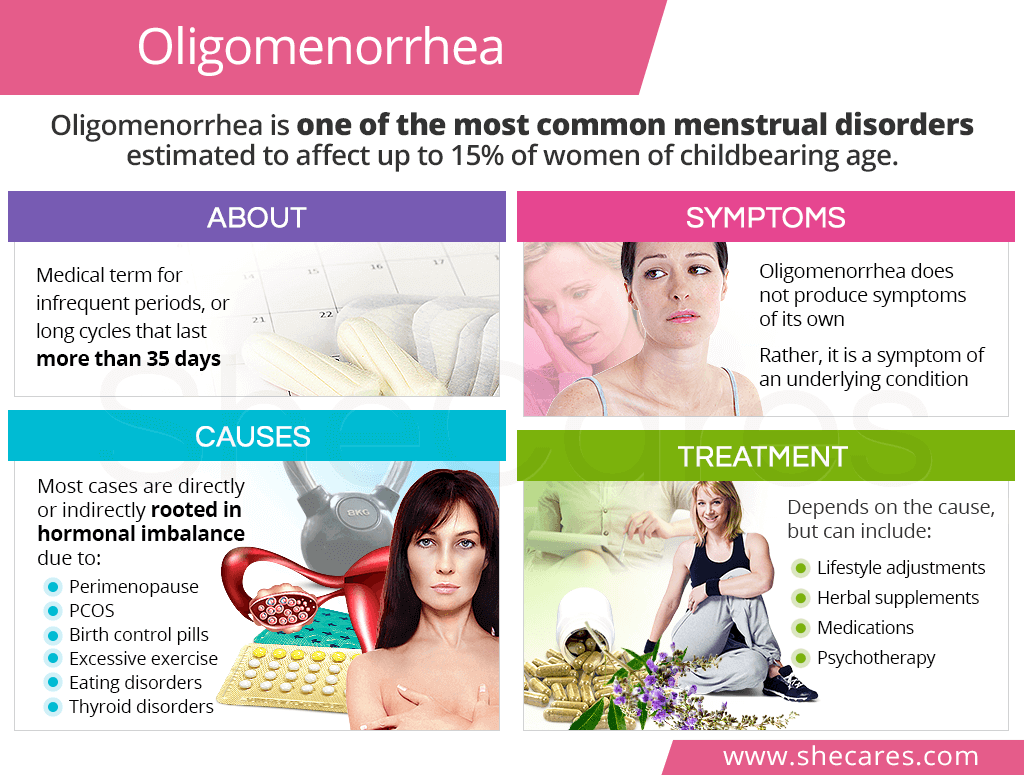What is Oligomenorrhea?

Oligomenorrhea is a medical term for infrequent periods. It is one of the most common menstrual disorders.
It could also be described as having long cycles, namely those that last longer than 35 days. With such long cycles, a woman's periods are less frequent, resulting in less than six to eight per year.2
For reference, a healthy menstrual cycle is defined as one that lasts between 21 and 35 days, with bleeding lasting for 3-7 days.3
While occasional period irregularities are common throughout a woman's reproductive years, those that persist for longer than three months generally call for an evaluation.
Oligomenorrhea Symptoms

Similarly to amenorrhea, or lack of periods, oligomenorrhea does not produce symptoms on its own. The only characteristic is long cycles that last over 35 days.
However, because infrequent cycles are indicative of other underlying conditions, they might be accompanied by other symptoms characteristic of them. They can include the following:
- Hair loss
- Headaches
- Vision changes
- Fatigue
- Excessive hair (hirsutism)
- Loss of libido
- Acne
- Hot flashes
What Causes Long Menstrual Cycles?

Infrequent periods is most commonly caused directly or indirectly by hormonal imbalance, which can be brought about by unhealthy lifestyle practices or medical conditions.
The most common long menstrual cycle causes are as follows:
- Birth control medications
- Polycystic ovary syndrome (PCOS)
- Perimenopause
- Strenuous exercise
- Insufficient body fat percentage
- Eating disorders, such as anorexia or bulimia nervosa
- Thyroid disorders, most commonly hyperthyroidism
- Hyperprolactinaemia, or high prolactin levels in the blood
- Medications side effects, like those for epilepsy or anxiety disorder
- Prolonged stress
- Diabetes mellitus
- Pituitary tumors
Oligomenorrhea Risks & Effects
Having infrequent periods long-term may expose a woman to potentially negative health risks, such as:
Fertility Problems
For a healthy couple of reproductive age, it might take up to a year to successfully get pregnant.4 Those trying to get pregnant with infrequent periods have lower chances of conceiving and might take longer to have a baby as there are less cycles in a given year.
Moreover, oligomenorrhea is likely to be accompanied by ovulation problems, including irregular or infrequent ovulation (oligoovulation) or even lack thereof (anovulation). Abnormal ovulation is one of the most common causes of infertility.
Endometrial Abnormalities
Studies have also found that infrequent periods in women with PCOS puts them at an elevated risk of endometrial hyperplasia (EP), an increased growth of the lining of the uterus called the endometrium.5 Having EP is a known factor for developing endometrial cancer.6
Diabetes Mellitus Type 2
Although further research is necessary for a better understanding of the connection, a study has found that long cycles are a potential risk factor for the development of diabetes type 2. Obese women (body mass index, BMI, above 25 kg/m2) are at a higher risk.7
Oligomenorrhea Treatment

The ultimate goal of oligomenorrhea treatment is to resolve the underlying cause. As such, the approaches will differ from woman to woman depending on her medical needs.
Generally, it is always beneficial to begin with the most natural approaches to treating oligomenorrhea and proceeding to pharmacological treatments if necessary. These can include the following:
Lifestyle adjustments. These approaches for treating long cycles can consist of improving one's diet to resolve nutritional deficiencies; modifying exercise routine to focus on moderate-intensity workouts of 150 minutes weekly; and practicing stress-relief techniques of yoga or deep breathing.
Alternative medicine. Herbal supplements that can help promote hormonal balance include phytoestrogenic supplements, like chasteberry, that provide the body with plant-based estrogens or hormone-regulating supplements, like Macafem, that optimize endocrine system function for overall balance.
Conventional medicine. Medications might be necessary to control medical conditions behind infrequent periods, including thyroid medications, birth control pills, or dopamine agonists, among others. It can also consist of psychotherapy for women with eating disorders.
Women whose infrequent periods are related to perimenopause might not require treatment as it is a natural phase in life as their ovaries near the end of their reproductive functions.
It is also worth noting that for optimal menstrual health, women are encouraged to keep track of their monthly patterns with period trackers.
Key Takeaways
A woman's menstrual patterns are a reflection of her overall health. So, when faced with irregularities, such as infrequent periods or long cycles, it calls for prompt evaluation to restore hormonal balance and achieve healthy menstruation. Oligomenorrhea, defined as cycles longer than 35 days, can be caused by a number of medical conditions and lifestyle habits, including PCOS, excessive exercise, eating disorders, or thyroid conditions. Since a great majority of those causes have hormonal roots, optimal treatment will be tailored to that specific cause and aimed at restoring equilibrium. Natural approaches to relieving long cycles can consists of implementing wholesome practices of balanced diet, exercise, and stress-relief techniques alongside alternative medicine, while conventional treatment can include medications as well as psychotherapy.
Sources
- Eunice Kennedy Shriver National Institute of Child Health and Human Development. (2017). What are menstrual irregularities? Retrieved December 5, 2019 from https://www.nichd.nih.gov/health/topics/menstruation/conditioninfo/irregularities
- Eunice Kennedy Shriver National Institute of Child Health and Human Development. (2017). What are the common treatments for menstrual irregularities? Retrieved December 5, 2019 from https://www.nichd.nih.gov/health/topics/menstruation/conditioninfo/treatments
- Health Direct. (2017). Irregular periods. Retrieved December 5, 2019 from https://www.healthdirect.gov.au/irregular-periods
- Mayo Clinic. (2019). Menstrual cycle: What's normal, what's not. Retrieved December 5, 2019 from https://www.mayoclinic.org/healthy-lifestyle/womens-health/in-depth/menstrual-cycle/art-20047186?pg=2
- nidirect. (n.d.). Irregular periods. Retrieved December 5, 2019 from https://www.nidirect.gov.uk/conditions/irregular-periods
- Office on Women's Health. (2018). Period problems. Retrieved December 5, 2019 from https://www.womenshealth.gov/menstrual-cycle/period-problems
- Office on Women's Health. (2018). Your menstrual cycle and your health. Retrieved December 5, 2019 from https://www.womenshealth.gov/menstrual-cycle/your-menstrual-cycle-and-your-health
- Women & Infants. (n.d.). Irregular Periods and Fertility. Retrieved December 5, 2019 from https://fertility.womenandinfants.org/services/women/irregular-periods-fertility
Footnotes:
- BioMed Research International. (2018). Herbal medicine for oligomenorrhea and amenorrhea: A systematic review of ancient and conventional medicine. Retrieved December 5, 2019 from https://www.ncbi.nlm.nih.gov/pmc/articles/PMC5878906/
- Welt, C. (2019). Patient education: Absent or irregular periods (Beyond the Basics). Retrieved December 5, 2019 from https://www.uptodate.com/contents/absent-or-irregular-periods-beyond-the-basics
- Cleveland Clinic. (2019). Abnormal Menstruation (Periods). Retrieved December 5, 2019 from https://my.clevelandclinic.org/health/diseases/14633-abnormal-menstruation-periods
- Better Health Channel. (2019). Infertility in women. Retrieved December 5, 2019 from https://www.betterhealth.vic.gov.au/health/ConditionsAndTreatments/infertility-in-women
- Open Journal of Obstetrics and Gynecology. (2018). Endometrial Thickness as a Predictor of Endometrial Hyperplasia in Infertile Patients with Polycystic Ovary Syndrome. Retrieved December 5, 2019 from https://www.scirp.org/journal/PaperInformation.aspx?paperID=82331&
- American Cancer Society. (n.d.). Endometrial Cancer Risk Factors. Retrieved December 5, 2019 from https://www.cancer.org/cancer/endometrial-cancer/causes-risks-prevention/risk-factors.html
- Diabetes & metabolism Journal. (2011). Long Menstrual Cycle is Associated with Type 2 Diabetes Mellitus in Korean Women. Retrieved December 5, 2019 from https://www.ncbi.nlm.nih.gov/pmc/articles/PMC3178699/


